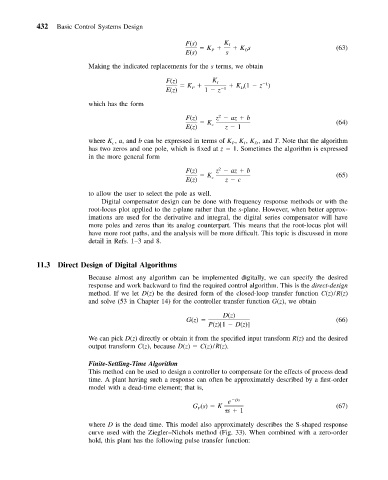Page 441 - Mechanical Engineers' Handbook (Volume 2)
P. 441
432 Basic Control Systems Design
F(s) K I
K Ks (63)
D
P
E(s) s
Making the indicated replacements for the s terms, we obtain
F(z) K I
1
K K (1 z )
E(z) P 1 z 1 D
which has the form
2
F(z) z az b
K (64)
E(z) c z 1
where K , a, and b can be expressed in terms of K , K , K , and T. Note that the algorithm
I
c
D
P
has two zeros and one pole, which is fixed at z 1. Sometimes the algorithm is expressed
in the more general form
2
F(z) z az b
K (65)
E(z) c z c
to allow the user to select the pole as well.
Digital compensator design can be done with frequency response methods or with the
root-locus plot applied to the z-plane rather than the s-plane. However, when better approx-
imations are used for the derivative and integral, the digital series compensator will have
more poles and zeros than its analog counterpart. This means that the root-locus plot will
have more root paths, and the analysis will be more difficult. This topic is discussed in more
detail in Refs. 1–3 and 8.
11.3 Direct Design of Digital Algorithms
Because almost any algorithm can be implemented digitally, we can specify the desired
response and work backward to find the required control algorithm. This is the direct-design
method. If we let D(z) be the desired form of the closed-loop transfer function C(z)/R(z)
and solve (53 in Chapter 14) for the controller transfer function G(z), we obtain
D(z)
G(z) (66)
P(z)[1 D(z)]
We can pick D(z) directly or obtain it from the specified input transform R(z) and the desired
output transform C(z), because D(z) C(z)/R(z).
Finite-Settling-Time Algorithm
This method can be used to design a controller to compensate for the effects of process dead
time. A plant having such a response can often be approximately described by a first-order
model with a dead-time element; that is,
e Ds
G (s) K (67)
P
s 1
where D is the dead time. This model also approximately describes the S-shaped response
curve used with the Ziegler–Nichols method (Fig. 33). When combined with a zero-order
hold, this plant has the following pulse transfer function:

